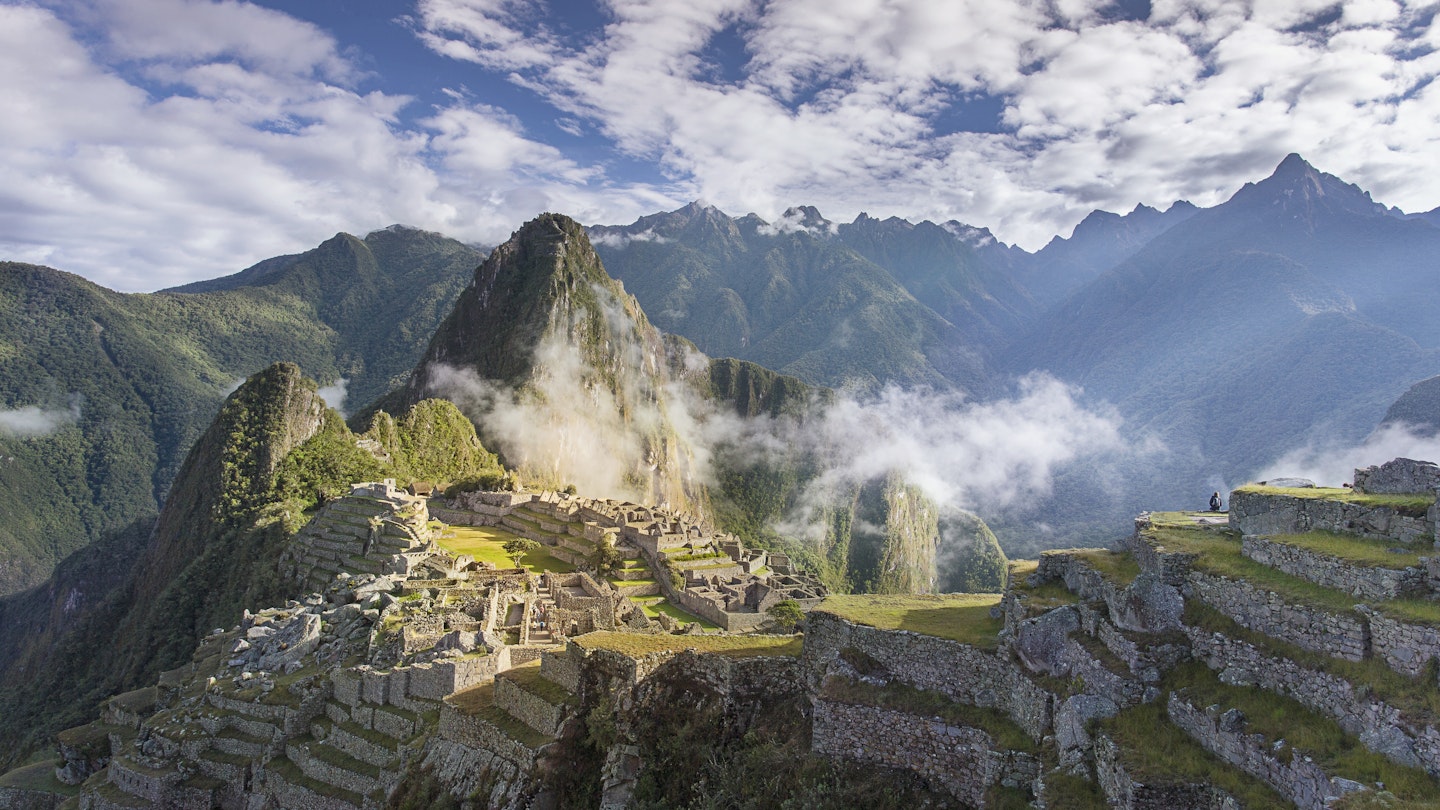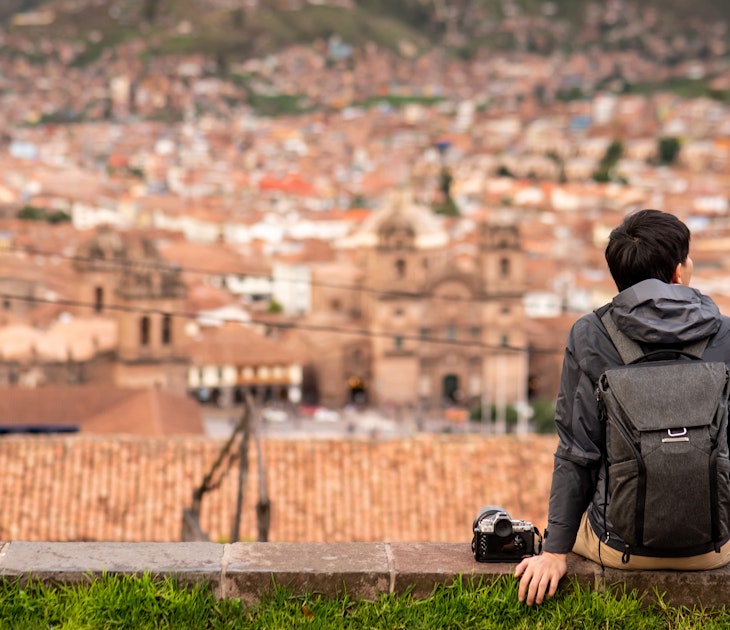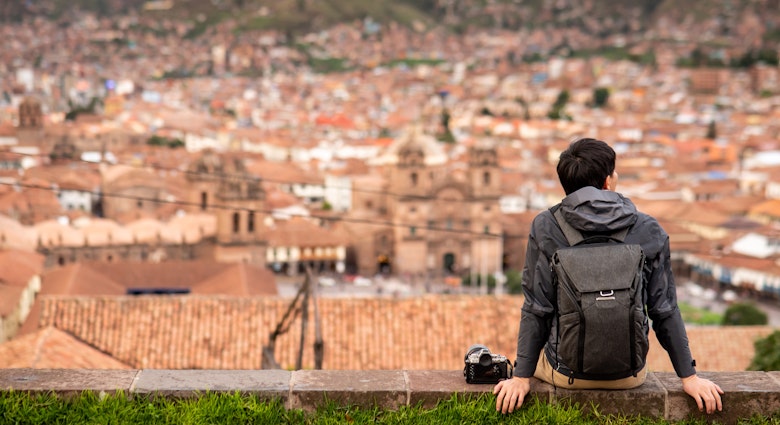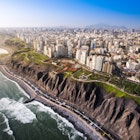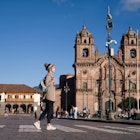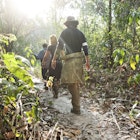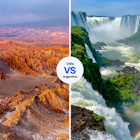When Hendrik-Jan Grievink and his girlfriend, Coralie Vogelaar, showed up in Cuzco in January 2022 in advance of their Inca Trail trek, the normally buzzing mountain town was quiet.
“There were empty restaurants, few tourists. And then we learned, the other couple who would be hiking with us canceled,” he says. The couple ended up hiking the trail alone, just the two of them, with an entire team of porters, chef, and tour guide catering to them.
“I felt very privileged and a little neo-colonial,” Hendrik says. “But Miguel, the owner of the company [Evolution Treks Peru], assured us they wanted us to have the experience. I felt they would probably lose money on it, but they wanted to continue.”
And that’s true. Vannia Llavillais is an Inca Trail tour guide based in Cuzco. “It was a very emotional moment to come back to the Inca Trail after two years,” she says. “I cried when I arrived at the entrance gate. I didn’t know how to explain the feelings I was experiencing to my clients. They couldn’t understand what I was feeling. I was so happy to have the opportunity to work on the Inca Trail again.”
And so, after two long years of a global pandemic, everyone is glad to be back on the Inca Trail.
That said, things are different in 2022 than they were in 2020, when the COVID-19 pandemic closed the trail and halted international travel. Here are some things to consider when you plan your Inca Trail adventure in 2022 — and all the reasons you should.
Are there still permits available for 2022?
Five hundred Inca Trail permits are available a day (generally divided into 200 clients and 300 porters, cooks, etc.). Right now, April and May are almost sold out, but 40% of the permits are still available for June and July and beyond, according to Miguel Angel Góngora Meza, cofounder of Evolution Treks Peru.
“It’s not as busy as it used to be,” says Zenobia Quispe, who works as a porter. “Even now, it is still not as crowded. But everyone is talking about how, within the next months, things are going to get the same way as they were in 2019, before the pandemic.”
How far in advance should I book my trip?
Two things are required to make your dream trip a reality: Booking a trek with a reputable tour company (you can’t hike the trail alone), and acquiring a coveted permit, which your tour company will take care of for you. Normally you need to book your trip six months or more ahead of time, but 2022 is different. With fewer people hiking the Inca Trail, you may have an excellent chance of finding space on a trek as well as acquiring a permit with little advance notice at all. It’s always smart to plan ahead as much as possible, but this year may be the one that you can cut it a little closer to the wire.

If you do plan to hike the Inca Trail in 2022, consider the fact that, as always, Inca Trail permits must be secured and paid in advance to have a guaranteed spot. All licensed Inca Trail tour operators require you to make a non-refundable deposit to secure your permits. If you need to back out, remember that permits are non-refundable, non-changeable, and non-transferable.
It's always a good idea to insure your trip, in order to recover your investment if you need to cancel your trip.
Hendrik says he and Coralie were a little late in booking their January 2022 trip. “Normally they tell you to book at least six months ahead, and we waited until November, but they arranged it, just like that.”
Are there entry requirements to enter Peru?
As of January 18, 2022, Peruvians, resident foreigners, and non-resident foreigners 12 years or old must present proof of being fully vaccinated 14 days prior to boarding their flight to Peru at their point of origin. Those who are not fully vaccinated must present a molecular test with a negative result (within 48 hours) prior to boarding an incoming flight to Peru.
To travel into the country’s interior (such as to Cuzco from Lima), all passengers older than 12 years using commercial transportation must present proof of vaccination to travel (40 and older must have received their booster). If you are not fully vaccinated, you must present a molecular test with a negative result (within 48 hours) prior to boarding your commercial transport.
All visitors must fill out an electronic health statement before arrival.
These mandates are in effect until August 28, 2022. You can find further information here and here.
Are there COVID-19 restrictions that apply to the Inca Trail itself?
The Peruvian Ministry of Health, the Peruvian Ministry of Culture, and SERNANP (the Department of Protected Natural Areas of Peru — the government agency that oversees the Inca Trail and Machu Picchu) require that all visitors wear two face masks or one KN95 mask at all checkpoints and areas of heavy traffic on the Inca Trail, including bathrooms and crowded campsites.
Park rangers control entrance gates, campsites, and other crowded areas.
“The park rangers check at the gate to make sure no one has a fever,” Zenobia says. “To make sure everyone is washing hands and wearing two masks where people are concentrated. They also randomly check at the campsites to make sure everyone is wearing a mask and keeping social distance.”
Are there precautions in place to help protect porters against COVID-19?
Companies generally provide hand sanitizer at meals, and visitors are encouraged to frequently wash their hands. “Be vaccinated,” says Miguel. That’s the best way to ensure everyone stays safe.
Responsible trekking in Peru: What you should know about workers' rights for porters
That said, each tour company is different, and this is one reason it’s important to be selective about the one that you choose. Read the reviews to see which ones care about their porters.

Here’s a tip: The ethical ones will be a little more expensive. If the price of a tour is cheap, that’s a pretty good indication the focus is on the bottom line. And this goes beyond COVID-19 precautions; it includes providing competitive wages, tents to sleep in, adequate meals, proper equipment, and more.
What are the companies doing to ensure their clients’ safety against COVID-19?
The porters, tour guides, cooks, and the rest of the team are generally vaccinated. “At some point, there was a vaccination post at the entrance to the Inca Trail, so tour guides and porters and everyone got vaccinated,” Miguel says. Even so, it’s a good question to ask the tour outfitter you are considering.
Some companies also do random testing of their porters each week. Many take simple precautions to ensure sanitary conditions.
“On the trail, the team provided us with disinfectant at every meal,” Hendrik says. “They kindly suggested we wash our hands every time before we ate.”
Again, do your research and ask these questions before booking your tours; also, be sure to check the reviews on social media. Not all companies are complying.
Is the trail crowded?
Trekking groups are limited to 10 people plus two tour guides or 8 people plus 1 guide; before the pandemic, groups capped out at 16 with two tour guides. The numbers are down right now, but the rest of the year promises to regain its pre-pandemic numbers.
“The trail itself was completely empty,” says Hendrik. “There were maybe two or three other vans at the same beginning point. In a couple of hours, we learned there were maybe three other groups, about 12 people total, doing the hike.”
That said, even when the trail is at capacity, groups are spread out. In pre-pandemic days, you mostly saw congestion at the campsites and at Machu Picchu itself.
So what about the campsites? Is that a problem?
Different groups converge at large campsites every night where they set up their tents. In pre-pandemic times, these sites bustled with trekkers, their tents crammed together.
“Right now, we have fewer groups at the campsites,” tour guide Monica Calderon says. “Normally there could be 30 groups, but right now, we have no more than 12.”
“The campsites have been expanded to allow for social distancing,” Miguel says. “Even when we have the same 500 people that are always been allowed on the Inca Trail, they will be more spread out both on the trail and at the campsites.”
Do I need to wear a mask when hiking?
Trekkers are not required to wear a mask while hiking, but it is recommended they put them on whenever they encounter a crowded area.
“We only had to wear masks at the beginning, at the check-in point. On the trail itself, we didn’t,” Hendrik says.
“During the hike, it’s not necessary to wear a mask because we have distance,” Monica says. “When we’re walking together in a group, the same team, we don’t wear a mask. But sometimes if we visit a small Inca site, we need to wear a mask, of course, because there are more tourists around.”
How did COVID-19 affect the porters?
The situation was dire for the porters, tour guides, chefs, and other staff that lead Inca Trail treks. Without tourists around, there was no work.
“Ninety-five percent of the place runs on tourism,” tour guide Marco Carrion says. “Tour guides and everyone had to find something else to do. Some sold food and vegetables in the streets. I can tell you, it was sad.”
“Everyone had sad stories of not making money, not working,” adds Zenobia. “Or if they found work, they had to work away from town, far from their families. Everyone was asking when the Inca Trail would open again.”
Without work, Zenobia suffered as well. She had nothing to offer her five children. “I felt so sad every time one of my kids asked me for something that I wasn’t able to provide.”
She worked two months for the local government in her village, but then that job dried up. The rest of the time she grew vegetables, potatoes, carrots, and greens to survive.
“When we returned to work on the trail, it was incredible,” Marco says. “On the first day (in July 2021), there was a big party with dancing, a big ceremony welcoming tourists.”
Should clients tip porters more to make up for losses due to the pandemic?
“It’s been hard around the world for everyone,” Monica says. “For us, it’s important to have this job. We have a salary. The porters and cooks have a salary.”
But the porters have a long way to go to make up for what they lost during the pandemic. Extra tipping is not mandatory, but even a little bit will go a long way and be much appreciated.

Something else to consider. The porters have a union, and at a recent meeting, they discussed the fact that some porters were being paid less than their deserved salary. Some companies are lowering their prices and giving perks to their clients in order to sell more. Usually, those that offer free porters, hot showers, etc., are compensating by paying their porters less.
The best thing to do is to research your tour outfitter to make sure they are ethical. Read social media reviews and ask questions. And again, take heed if the tour price is too good to be true.
What about visiting Machu Picchu itself? Are there any restrictions?
At the end of the Inca Trail trek awaits the splendor of Machu Picchu — which in pre-pandemic times always involved a bit of shock as trekkers emerged from the quietude of nature into the frenzy of the tourist-filled historic site.
Minding Machu Picchu: how to see Peru’s most famous ruins responsibly
The number of people who can visit Machu Picchu is now capped at 2,244 a day (including day-visitors, overnight hikers, professional guides, etc.), with three different time slots available (from 6 am to 9 am, from 9 am to 12 pm, and from 12 pm to 2 am).
Precautions have been executed so that temples and palaces and other places of interests don’t become overcrowded. “They don’t allow tour guides to stop a long time; 5 or 7 minutes at the most,” Miguel says.
There are also four different circuits that have been implemented for better crowd control.
So, should I hike the Inca Trail in 2022?
“I’m reluctant to share things on social media,” Hendrik says, “but I shared the trek, and got an amazing response. I think the whole world forgot travel is possible. It takes a little more preparation and organization than normal, but it’s so worth it.”
Monica provides these words of encouragement: “The Inca Trail is safe, my friends. We wear masks. We use hand sanitizer. The cook is very careful with food. The porters clean everything before the tourists arrive at the camp. It’s totally safe for tourists to visit the Inca Trail this year. And it’s the best time to visit, because we’re not totally full.”
Bottom line: Yes, you can hike the Inca Trail, and now is the time to do it!
You may also like:
Experience the best of Peru with these 8 iconic hikes
10 best beaches in Peru

